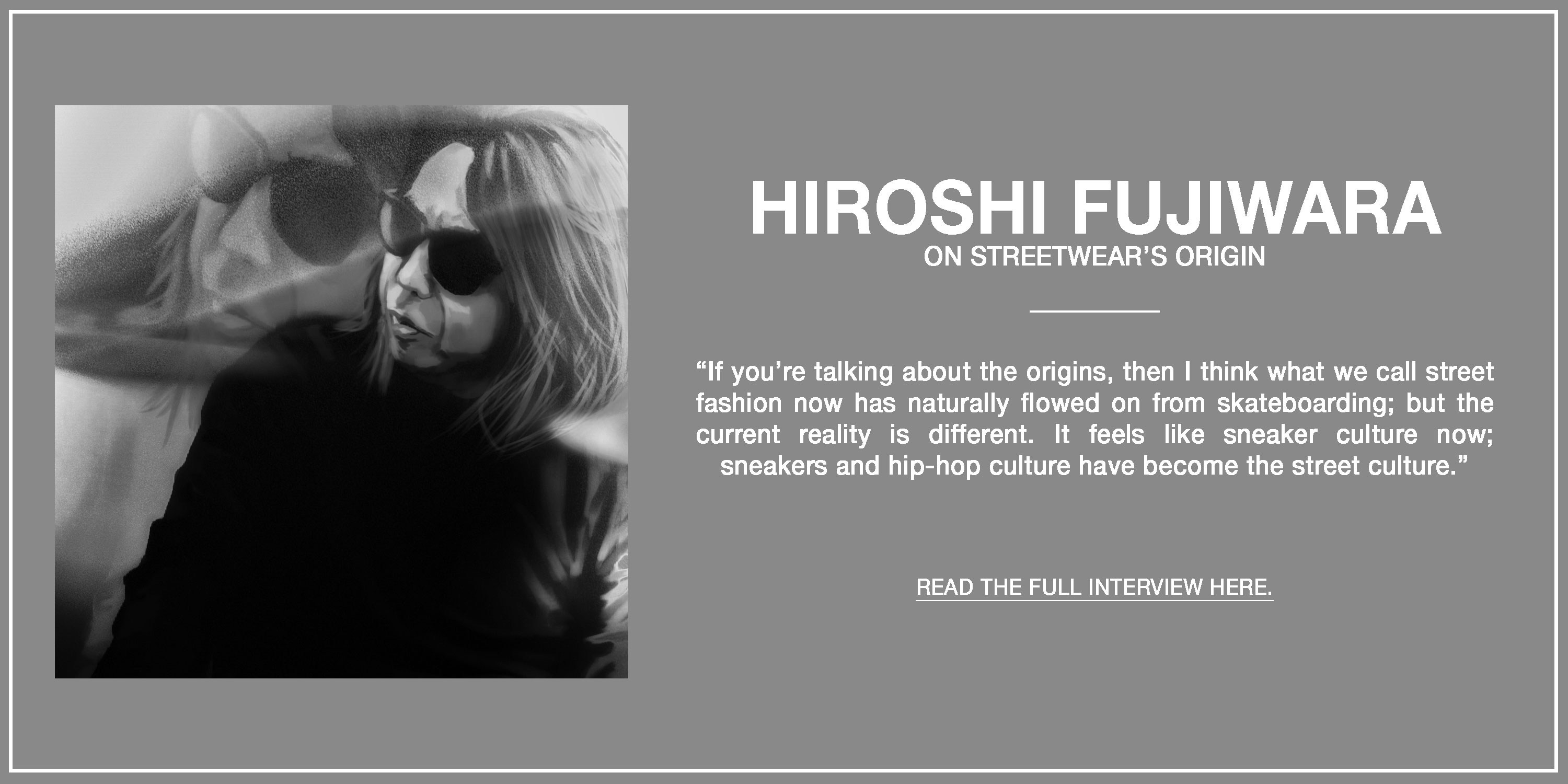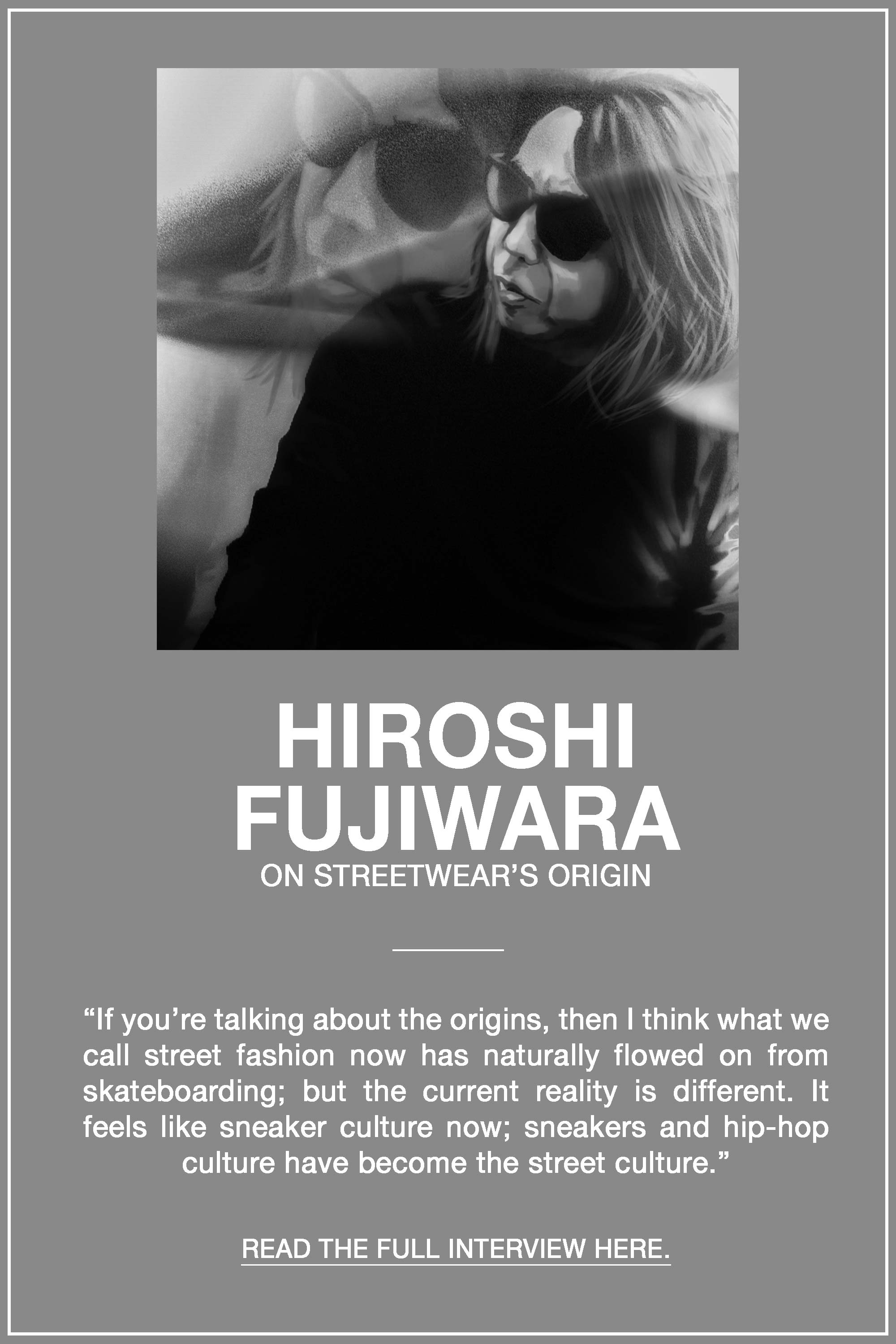Street Wear Fashion for Muscle Men
This article is function of the Streetwear Touch Report . The report includes data collected through ii main enquiry methods: our consumer survey and industry survey. Total description of methodology tin can be constitute in the Introduction.
The report is divide into 4 articles. 001 Defining Streetwear details streetwear'southward origin and key cultural components. 002 Measuring Streetwear reports consumer spending habits and preferences. 003 How Streetwear Talks traces the communication loop between consumer and make. 004 How Streetwear Sells dissects streetwear's tight-knit direct-to-consumer relationship and retail model. Visit the Executive Summary for a full overview.
Streetwear'due south dictionary definition is simple plenty: fashionable, casual clothes. But that definition underplays what has become a multi billion-dollar retail miracle, with roots in countercultures of the 1980s and 1990s, including graffiti, hip-hop, skate and surf.
In essence, streetwear involves the production, promotion, sale and resale of coincidental fashion, principally of footwear, such as sneakers, but also T-shirts and other items – in ways that bypass traditional retail channels, frequently subverting the style the fashion manufacture has long defined and dictated how "cool" is fabricated profitable. The audience, and therefore the target marketplace, is very young: mostly under 25.
The communities that originally led streetwear were largely male dominated, and as such the style was originally adopted and driven past men, depicting traditionally masculine looks. In the beginning, streetwear was uncomplicated and an antitoxin to the elaborate, complicated styles that were in way at the time. The formula was straightforward: people wore T-shirts and hoodies because that's what they liked. This uniform was tied to both comfort and self-expression.
Pioneers of the movement include James Jebbia, founder of skate brand Supreme, and Shawn Stussy, founder of surf make Stüssy. Designer Dapper Dan played a pivotal function in elevating streetwear to luxury as early as the 1980's out of Harlem, New York, creating styles for hip-hop artists who were shunned by traditional luxury brands at the time.
While the movement has roots in California and New York, other early adopters like Hiroshi Fujiwara and Nigo, both influential DJs and designers, were largely responsible for pioneering the street style and hip-hop scene in Japan in the 1980s. Like other major cultural movements, streetwear quickly rose simultaneously in major cities and regions throughout the globe.


And, like any major cultural movement, streetwear has not risen in a vacuum. Streetwear should not be viewed as a trend within fashion, but equally the fashion leg of a larger shift that has given power to popular civilisation spanning style, art and music, and which is largely driven by black civilisation.
The mindset that drives this popular civilization shift appeared equally early as 1960s, when Andy Warhol questioned what constituted contemporary fine art. In the 1970s, artists such as Jean-Michel Basquiat and Keith Haring extended this chat to street art, challenging traditional notions of who could access art and who it was for.
Hip-hop and rap similarly promoted a raw form of music motivated past dominion breaking and finding art and sound in unconventional ways. Streetwear is analogous to an creative person's street art or a hip-hop creative person's lyrics: picking a spot and dropping a signature.
This level of authenticity is unmatched elsewhere in the fashion industry, which has typically operated through a pinnacle-down effect. Insiders act as the gatekeepers to the newest styles and trends. Streetwear has subverted this formula with a more democratic model.
With streetwear, the tastemakers are not only taking direction from style that comes from the streets, they are taking direction directly from the audience. It'due south the consumer who has the power to determine what's cool every bit much as the industry insider. The muscle of traditional fashion institutions – such as print publications and revered editors – has dwindled, while the opinions of general audiences accept gained weight.
Streetwear derives its staying power from merging the original codes of luxury fashion with something new. Our consumer survey findings revealed that most (70%) consumer respondents like streetwear because it's cool, while more than than half (57%) consider comfortable clothes to be a cardinal gene. Additionally, close to half (46%) identify importance on exclusivity, while around a quarter value condition symbol (27%) and community (24%).
While a brand'south coolness, exclusivity and condition symbol accept long been integral to manner, streetwear introduces new cardinal players: comfortable clothing and community. The exclusivity that drives streetwear, meanwhile, is driven more so by know-how than financial capacity to buy. For brands, tapping into this in-oversupply mindset poses the highest barrier to entry.
Each streetwear make's value is derived from a range of sources, including product quality and pattern, celebrity followers, musicians and artists. But, arguably, no factor is perceived to be as important every bit authenticity, garnered by relating directly to the customers buying the products.
About major fashion brands, luxury and mass market alike, are shifting their strategies to incorporate streetwear. Indeed, in our global industry survey of manner and retail executives, 76% of respondents said they believed streetwear will proceed to grow significantly over the side by side five years. Indeed, in a global survey of style and retail manufacture executives that we recently completed, 76% of respondents said they believed streetwear will continue to grow significantly over the next five years.
Fundamental moments in the manufacture have signaled streetwear's growing dominance. In 2017, a collaboration between Supreme and Louis Vuitton marked a turning point for luxury manner's awareness of streetwear. Vuitton appointed Virgil Abloh, a lauded streetwear designer, as creative manager of menswear in 2018. Elsewhere, large-scale investment in streetwear has become increasingly common, headlined by Supreme'south sale to The Carlyle Group in 2017 for an estimated US$500 million. Other streetwear brands, such as Japan's A Bathing Ape (BAPE), received investment as early every bit 2011. In 2018, footwear retailer Concepts struck a deal with Amazon-owned Zappos and Stadium Goods received backing from LVMH.
What began as a niche culture – literally starting with the printing of logos on T-shirts – is now a principal commuter in the mode industry, adopted by all genders and stretching from luxury to mall brands.
The current state of streetwear can be defined in four cardinal means:
-
Original streetwear brands are characterized past an attainable price signal, comfy clothing and authenticity. At their core, these brands are driven by a very direct motivation to put a word on a T-shirt. These brands include founding fathers such every bit Supreme, BAPE and Stüssy, equally well as newer players such as Palace. Products from these brands often resell at a high price point due to scarcity and loftier demand.
-
Sportswear brands include leading athletic labels whose offering of athletic wear and sneakers are integral to the streetwear style. Sneakers created past brands such as adidas and Nike are cornerstones of the streetwear uniform.
-
Adopted streetwear brands have incorporated streetwear trends and styles into their production offering, only their make origin is not authentically tied to the streetwear movement. This can include luxury and mass-market brands akin.
-
Luxury streetwear brands reflect the most recent emergence of brands that blur the lines betwixt original streetwear and luxury fashion. These brands are likewise driven by authenticity merely operate at a higher cost betoken and diverge from the standard streetwear uniform. This includes brands such as Off-white™, Ambush and Vetements.
0 Response to "Street Wear Fashion for Muscle Men"
Post a Comment